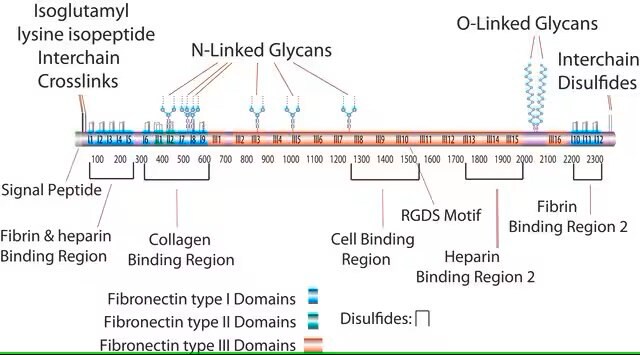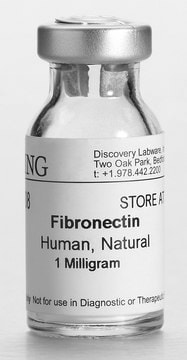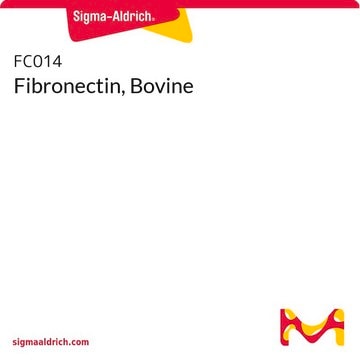Human fibronectin is composed of two nearly identical disulfide bound peptides. Each has a molecular weight of 220 kDa for a combined total of 440 kDa.
F1056
Human Fibronectin
from human plasma, powder, suitable for cell culture
Synonym(e):
Fibronectin
Größe auswählen
Größe auswählen
About This Item
Empfohlene Produkte
Produktbezeichnung
Fibronektin-Humanplasma, lyophilized powder, BioReagent, suitable for cell culture, ≥95% (SDS-PAGE)
Biologische Quelle
human plasma
Qualitätsniveau
Sterilität
sterile
Produktlinie
BioReagent
Assay
≥95% (SDS-PAGE)
Form
lyophilized powder
Verpackung
pkg of 1 mg
pkg of 2 mg
pkg of 5 mg
Methode(n)
cell culture | mammalian: suitable
Oberflächendeckung
1‑5 μg/cm2
Löslichkeit
H2O: 1 mg/mL at 37 °C
UniProt-Hinterlegungsnummer
Bindungsspezifität
Peptide Source: Collagen
Versandbedingung
dry ice
Lagertemp.
−20°C
Angaben zum Gen
human ... FN1(2335)
Suchen Sie nach ähnlichen Produkten? Aufrufen Leitfaden zum Produktvergleich
Allgemeine Beschreibung
Anwendung
Biochem./physiol. Wirkung
Vorsicht
Angaben zur Herstellung
Bei der Beschichtung von Kulturoberflächen sollte Fibronektin in ausgeglichener steriler Kochsalzlösung verdünnt und möglichst dünn aufgetragen werden. Die behandelte Oberfläche sollte dann 45 Minuten bei Raumtemperatur luftgetrocknet werden und ist 2–4 Wochen bei 2–8 °C haltbar.
Haftungsausschluss
Lagerklassenschlüssel
11 - Combustible Solids
WGK
WGK 3
Flammpunkt (°F)
Not applicable
Flammpunkt (°C)
Not applicable
Persönliche Schutzausrüstung
Eyeshields, Gloves, type N95 (US)
Hier finden Sie alle aktuellen Versionen:
Analysenzertifikate (COA)
Die passende Version wird nicht angezeigt?
Wenn Sie eine bestimmte Version benötigen, können Sie anhand der Lot- oder Chargennummer nach einem spezifischen Zertifikat suchen.
Besitzen Sie dieses Produkt bereits?
In der Dokumentenbibliothek finden Sie die Dokumentation zu den Produkten, die Sie kürzlich erworben haben.
Kunden haben sich ebenfalls angesehen
Artikel
Extracellular matrix proteins such as laminin, collagen, and fibronectin can be used as cell attachment substrates in cell culture.
Protokolle
Fibronectin auf die gewünschte Konzentration verdünnen. Die optimalen Anhaftungsbedingungen sind vom Zelltyp und der Anwendung abhängig. Die typische Beschichtungskonzentration beträgt 1–5 ug/cm2. Protokoll, Produkte und häufig gestellte Fragen zur Fibronectin-Beschichtung.
Dilute fibronectin for cell attachment, varying per cell type. Coating protocol, products, and FAQs provided.
-
What is the molecular weight of this product?
1 Antwort-
Hilfreich?
-
-
This is to ask a question regarding coating flasks with the human freeze-dried fibronectin (F1056). After dissolving it in sterile water and diluting to the desired concentration should I incubate the flasks at 4 or 37 degrees overnight? Many thanks!
1 Antwort-
As noted in the DESCRIPTION section of the Product Detail Page, fibronectin should be diluted in a sterile balanced sterile salt solution and coated with minimal volume. The surface should then be air dried for 45 minutes at room temp and can be stored for 2-4 weeks at 2-8°C. See the information below for a brief protocol:
To coat culture surfaces:
1. Dilute fibronectin in a sterile balanced salt solution
and coat the culture surface (1-5 mg/cm2) with a
minimal volume.
2. Allow to air dry for at least 45 minutes at room
temperature, Excess fibronectin may be removed
by aspiration, but this is not necessary.
3. Fibronectin coated cultureware can be stored for
2-4 weeks at 2-8 °C in a closed sterile container or
sterile sealable bags.Hilfreich?
-
-
How do I solubilized Fibronectin?
1 Antwort-
Dissolve at 1 mg/mL in water. Allow to dissolve for at least 30 minutes at 37 °C. A small amount of undissolved material may remain. This will not affect product performance.
Hilfreich?
-
-
How do I choose which fibronectin product to use to coat culture surfaces for cell growth?
1 Antwort-
The species source for the fibronectin used when coating culture surfaces is not important. It is the presence of the RGD binding site that is present in all fibronectins that promotes binding.
Hilfreich?
-
-
How long can I store the fibronectin solution?
1 Antwort-
The product is good for at least a year at 2-8 °C if kept sterile.
Hilfreich?
-
-
What is the Department of Transportation shipping information for this product?
1 Antwort-
Transportation information can be found in Section 14 of the product's (M)SDS.To access the shipping information for this material, use the link on the product detail page for the product.
Hilfreich?
-
-
How do I determine how much fibronectin is in solution?
1 Antwort-
As the product may contain undissolved material, the amount of fibronectin in solution can be determined by UV absorbance. The extinction coefficient for a 1% solution (10 mg/ml) is 13.5 at 280 nm.
Hilfreich?
-
-
How do I test the wells/flasks that have been coated with fibronectin?
1 Antwort-
We test the coated culture surface by culturing cells. We compare the adherence of the cells to wells that have been coated with media containing BSA (negative) and media containing 10% FBS (positive). The cell growth should be not less than 50% of the positive control and greater than 50% of the negative control.
Hilfreich?
-
-
What is the difference between Fibronectin Products F2006 and F1056?
1 Antwort-
The difference between Product Nos. F2006 and F1056 is in the purity specifications and endotoxin testing. Product No. F2006 has a purity specification of ≥90% and is not tested for endotoxin contamination. Product No. F1056 has a purity specification of ≥95% and is tested for endotoxin contamination with a specification of ≤100 EU/mg.
Hilfreich?
-
-
What is the procedure for coating culture surfaces with fibronectin?
1 Antwort-
To coat culture surfaces: 1. Dilute fibronectin in sterile balanced salt solution and coat the culture surface (1-5 μg/cm2) with a minimal volume. 2. Allow to air dry for at least 45 minutes at room temperature. Excess fibronectin may be removed by aspiration, but this is not necessary.
Hilfreich?
-
Aktive Filter
Unser Team von Wissenschaftlern verfügt über Erfahrung in allen Forschungsbereichen einschließlich Life Science, Materialwissenschaften, chemischer Synthese, Chromatographie, Analytik und vielen mehr..
Setzen Sie sich mit dem technischen Dienst in Verbindung.







